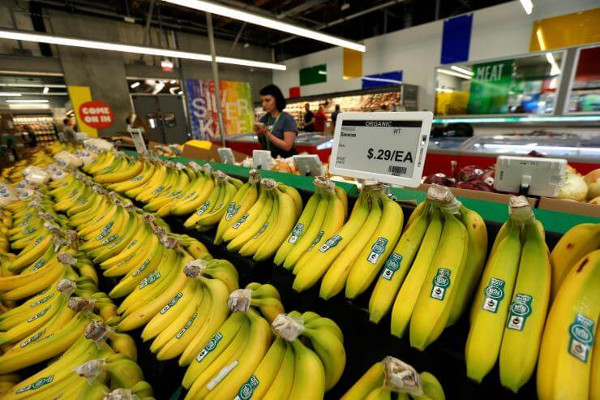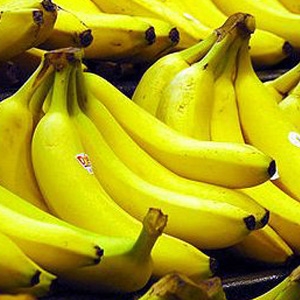The world’s fave banana still faces extinction from a pervasive fugal infection called Panama Disease. We first reported on this story back in 2016. The good news is, scientists are making headway on breeding a disease-resistant version…
 The banana is the single most popular fruit in the world. It gets more counter
The banana is the single most popular fruit in the world. It gets more counter
space than all the apple varieties together. Now, the world’s most
popular banana is threatened with extinction…
A monoculture-based issue
Back in the mid-20-teens, scientists discovered that a virulent fungal disease was infesting Cavendish banana plantations in Central and South America.
“Since then it has spread to India and China, the world’s largest producers of bananas. It has also spread to the Middle East and Africa and very recently was found in South America,” said James Dale, a professor, and leader of the banana biotechnology program at Queensland University of Technology.
More than 1,000 banana varieties are cultivated around the world. The Cavendish is just one. But it accounts for almost 50 percent of the bananas consumed by humans. And it’s by far the most prevalent variety exported to markets where bananas are not native.
A recent Business Insider (BI) exposée on the issue reveals three main reasons that growers have gravitated towards the Cavendish and away from other varieties:
“One, it’s resistant to some of the major banana-killing diseases; two, it has a long shelf life; and three, farmers can typically grow more Cavendish bananas than other varieties on the same amount of land.”
“Because of all these reasons, Cavendish becomes a very practical product,” Dan Koeppel, author of the book Banana: The Fate of the Fruit That Changed the World,” told BI.
What they’re doing
Scientists around the world are working feverishly on breeding a Cavendish variant that’s resistant to Panama Disease. But that kind of development program can take decades.
According to BI, Australian researchers have developed a genetically modified Cavendish called QCAV-4, which they say is highly resistant to Panama Disease. But not totally immune.
Meanwhile, folks who oppose genetically-manipulated organisms (GMOs) are watching the process closely. As you might expect.
Meanwhile, exporters are also looking at possible replacements for the Cavendish. Thanks to the new awareness in the West of non-indigenous foods over the last couple of decades, we’ve been exposed to many new produce varieties. Demand from the influx of immigrants from around the globe has resulted in importers bring newcomers’ favourite non-Cavendish banana types into Western markets.
What the future might hold
If efforts to save the Cavendish banana from extinction are not successful, we’ll face a short list of choices. They’ll be influenced by some pretty powerful economic and practical factors.
First, the masses of banana consumers around the world are used to the Cavendish: Its trademark bright yellow skin; its soft, sweet interior; its long shelf life; its easily manageable medium size. Other banana types range from the super-sweet African ‘Finger’ banana to the huge, starchy Caribbean Plantain. None of the available fungus-resistant varieties is a direct replacement for the Cavendish, in terms of our taste expectations or as an ingredient in our favourite recipes.
Second, any replacement banana coming into the market would cost considerably more than the Cavendish. Some observers say, as much as (US)$4 per pound / (US)$8.80 kg. That wouldn’t go over very well with banana fans. They might just switch to something cheaper – like apples. Or just about any other domestic fruit, in season.
Third, if the banana industry decided to diversify, and offer the masses a variety of types – like the apple growers – it would cause mayhem. Apples, you can just toss in cold storage for up to a year. The banana people would have to adapt to accommodate different harvesting, shipping and ripening requirements of each new banana type. The cost would be astronomical.
Doomed to repeat history?
“The answer is going to be the end of monoculture. The answer is variety,” Dan Koppel opines. He refers to requiring growers to produce a diverse selection of bananas to ensue that the extinction of no single variety in the future can crash the industry again.
Politicians might be able to legislate on it, but most, I suspect, would be too timid to stand up to ‘Big Bananas’.
Left to their own devices, banana growers will almost certainly keep doing what they’ve always done. What they know how to do. They’ll want to find the single best variety of the fruit that has the best acceptance in their export markets. And they’ll grow it by the same monoculture method they’ve been using for the Cavendish.
Agronomists and crop scientists warn that monoculture farming is a bad thing on many accounts. Not the least of which is, it’s a recipe for disaster if a virulent crop disease takes hold.
The Cavendish’s predecessor, called the Gros Michel, succumbed to a disease similar to Panama Disease, several decades ago. Banana producers had been growing it in preference to other varieties for more than 100 years. But a fungus, “began infecting bananas in 1876. By the 1950s, it had completely decimated Gros Michel farms, forcing banana producers across the globe to look for a new variety.” Enter the Cavendish. Now it could be headed for the same fate…
What next?
~ Maggie J.

